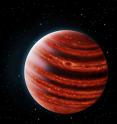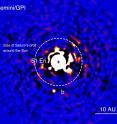Methane, water enshroud nearby Jupiter-like exoplanet
Related images
(click to enlarge)
The Gemini Planet Imager has discovered and photographed its first planet, a methane-enshrouded gas giant much like Jupiter that may hold the key to understanding how large planets form in the swirling accretion disks around stars. The GPI instrument, which is mounted on the 8-meter Gemini South telescope in Chile, is the size of a small car and was designed, built and optimized for imaging and analyzing the atmospheres of faint Jupiter-like planets next to bright stars, thanks to a device that masks the star's glare.
In December 2104, GPI began searching hundreds of nearby young stars, and after a mere month, University of California, Berkeley, postdoctoral fellow Robert De Rosa began looking at the initial data. He soon noticed something large orbiting a young star in a triple-star system only 100 light years from Earth. He and graduate student Jason Wang summoned the GPI team, which confirmed the planet.
The planet, dubbed 51 Eridani b, is a million times fainter than its star, 51 Eridani, and shows the strongest methane signature ever detected on an alien planet, which should yield clues as to how the planet formed. The planetary system is very young - around 20 million years old, compared to our own 4.5 billion-year-old solar system - and provides a view of what Jupiter might have looked like in its infancy.
"This is exactly the kind of planet we envisioned discovering when we designed GPI," said James Graham, a UC Berkeley professor of astronomy and the GPI project scientist. "We wanted to find planets when they're young so we can figure out the formation process."
The planet is estimated to be about twice the mass of Jupiter, and orbits at a distance of 13 AU, or slightly farther from its star than Saturn is from the sun. An AU is equal to the Earth-sun distance, or 150 million kilometers (93 million miles). Two of the stars in the system form a close pair far from the planet's host star, and apparently do not affect the planet's orbit.
Spectra of the planet reveal methane gas as well as water similar to the conditions thought to occur deep in Jupiter's atmosphere..
"Judging by its low luminosity, low temperature and strong methane signature, this is the most Jupiter-like exoplanet ever directly imaged," said Graham,
"Many of the exoplanets astronomers have studied before have atmospheres that look like very cool stars," said Bruce Macintosh, a professor of physics in the Kavli Institute at Stanford University who led the construction of GPI and now leads the survey. "This one looks like a planet."
Graham, Macintosh, De Rosa, Wang and their team members will publish their results online Aug. 13 in Science Express.
Hot start vs cold start
Astronomers believe that the gas giants in our solar system formed by building up a large rocky core over a few million years and then pulling in a huge amount of hydrogen and other gasses to form an atmosphere. But the gas-giants exoplanets discovered by direct imaging that have so far been discovered are hot, hinting that they formed much faster as material collapsed rapidly to make a very hot planet, so called "hot-start" scenario. The cold-start scenario, called core accretion, can also form rocky planets like Earth and Mars, but the hot-start model of gravitational collapse might only make giant gas planets.
The low temperature of 51 Eridani b, estimated to be about 430 Celsius (800 Fahrenheit), may mean that this is the first example of a directly imaged planet that is consistent with a cold-start formation mechanism, the team concluded.
"51 Eri b is the first one that's cold enough and close enough to the star that it could have indeed formed right where it is the 'old-fashioned way,'" Macintosh said. "This planet really could have formed the same way Jupiter did - this whole planetary system could be a lot like ours."
There are hundreds of planets a little bigger than Earth out there, Macintosh said, but there is so far no way to know if they are really "super-Earths" or just micro-sized gas and ice planets like Neptune or something different all together. Using GPI to study more young solar systems such as 51 Eridani, he said, will help astronomers understand the formation of our neighbor planets, and how common that planet-forming mechanism is throughout the universe.
"Our knowledge today of how planets form reminds me of our knowledge 50-60 years ago of how stars form," Graham said.
Direct imaging
Fewer than a handful of exoplanets have been imaged, but even without an image, astronomers have found ways to study their atmospheres. When a planet passes in front of its star - a so-called transit - some of the star's light is blocked or absorbed, yielding a spectral signature of the chemicals in the atmosphere. The frequencies (wavelengths or colors) of light reflected by a planet can provide similar information.
But those techniques sample only a thin layer of material at the very top of the atmosphere, Graham said. GPI detects light emitted directly by planets, rather than light reflected or transmitted through the atmosphere. This light is from the heat remaining after gravitational collapse of gas and dust that formed the planet. When we look at Jupiter, half the light we see, primarily in the infrared, comes from internal heat remaining after its collapse into a planet 4.5 billion years ago.
The new planet is so young that nearly all the observed light comes from inside, allowing astronomers to sample the chemical structure in different atmospheric layers.
The team plans to begin observing the planet again in late September, when it emerges from behind the sun, and hope to find that the planet has moved along its orbit: confirmation that it is, in fact, a planet.
Source: University of California - Berkeley
Articles on the same topic
- Young, Jupiter-like planet discoveredThu, 13 Aug 2015, 21:13:43 UTC
- Astronomers discover 'young Jupiter' exoplanetThu, 13 Aug 2015, 21:13:31 UTC
- Lawrence Livermore scientists discover new young planetThu, 13 Aug 2015, 21:01:54 UTC
- Astronomers discover 'young Jupiter' exoplanetThu, 13 Aug 2015, 20:13:54 UTC
- Jupiter-like planet discovered outside our solar systemThu, 13 Aug 2015, 20:13:41 UTC
- Astronomers discover 'young Jupiter' exoplanetThu, 13 Aug 2015, 18:57:41 UTC
- Astronomers discover 'young Jupiter' exoplanetThu, 13 Aug 2015, 18:57:21 UTC
- Astronomers discover 'young Jupiter' exoplanetThu, 13 Aug 2015, 18:56:55 UTC
- Gemini-discovered world is most like JupiterThu, 13 Aug 2015, 18:56:44 UTC
Other sources
- 'Young Jupiter' exoplanet discovery: Q&A with astronomer Eric Nielsenfrom PhysorgMon, 17 Aug 2015, 14:30:45 UTC
- Found! 'Young Jupiter,' the Smallest Exoplanet Directly Seen by Telescopefrom Live ScienceFri, 14 Aug 2015, 22:30:20 UTC
- Distant "young Jupiter" could shed light on solar systemfrom CBSNews - ScienceFri, 14 Aug 2015, 16:00:24 UTC
- Young 'alien Jupiter' discoveredfrom BBC News: Science & NatureFri, 14 Aug 2015, 11:10:16 UTC
- Young, Jupiter-like planet discoveredfrom Science BlogThu, 13 Aug 2015, 23:10:09 UTC
- Astronomers photograph a baby Jupiter in another solar systemfrom Reuters:ScienceThu, 13 Aug 2015, 23:10:06 UTC
- Astronomers Discover 'Young Jupiter' Exoplanetfrom Newswise - ScinewsThu, 13 Aug 2015, 21:00:07 UTC
- Baby Jupiter discovered by new planet-hunting camerafrom CBC: Technology & ScienceThu, 13 Aug 2015, 19:20:08 UTC
- Astronomers discover 'young Jupiter' exoplanetfrom Science DailyThu, 13 Aug 2015, 18:50:36 UTC
- Found! 'Young Jupiter,' the Smallest Exoplanet Directly Seen by Telescopefrom Space.comThu, 13 Aug 2015, 18:50:29 UTC
- Methane, water enshroud nearby Jupiter-like exoplanetfrom PhysorgThu, 13 Aug 2015, 18:21:13 UTC
- Astronomers Glimpse a Young Jupiter, 51 Eridani bfrom Scientific AmericanThu, 13 Aug 2015, 18:20:53 UTC
- 'Young Jupiter' Discovered 100 Light-Years Awayfrom MSNBC: ScienceThu, 13 Aug 2015, 18:20:51 UTC
- 'Young Jupiter' 51 Eridani b: Why Directly Imaging an Exoplanet Is Big (Kavli Q+A)from Space.comThu, 13 Aug 2015, 18:20:27 UTC
- Exoplanet 51 Eridani b: A Red-Hot Young Jupiter Around Distant Star (Infographic)from Space.comThu, 13 Aug 2015, 18:20:26 UTC
- Astronomers Discover "Young Jupiter" Exoplanetfrom Newswise - ScinewsThu, 13 Aug 2015, 18:20:09 UTC
- Astronomers Discover 'Young Jupiter' Exoplanetfrom Newswise - ScinewsThu, 13 Aug 2015, 18:20:05 UTC

